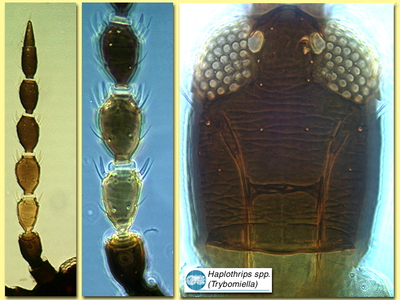Figures
Fig. 1 Antenna and head
Fig. 2 Pronotum
Fig. 3 Fore and hind wing
Fig. 4 Tarsus and tergite X (tube)
Species
Haplothrips (Trybomiella) spp.Biology
All of the species in this sub-genus are apparently flower-feeding.
Distribution
Trybomiella species are found in Australia, Africa and South America, and the common Australian species,H. robustus, has been recorded from Hawaii, southern U.S.A. and Mexico.
Recognition
Large dark brown thrips with antennal segment III scarcely paler; forewing pale with extreme base dark. Antennae 8-segmented; segment III with 2 sense cones, IV with 4 sense cones; segment III scarcely shorter than IV. Head with maxillary stylets about one-third of head width apart, with distinct maxillary bridge; postocular setae pale with apex capitate. Pronotum with 4 pairs of major setae, all pale with capitate apex (midlateral pair of setae not developed). Fore tarsus of female with minute tarsal tooth. Forewing unusually broad, constricted medially; distal posterior margin with no duplicated cilia; sub-basal setae pale with apex capitate. Tergites II-VII each with 2 pairs of sigmoid wing-retaining setae; tergite IX mid-dorsal setae with apex blunt but more than half as long as tube, lateral setae acute.





